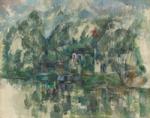At the Water's Edge
Paul Cézanne
National Gallery of Art
Washington, US
circa 1890 In this horizontal landscape painting, we observe two houses, smaller outbuildings, and a houseboat across a body of water. The artist, Cézanne, employs thin and loose strokes in a palette of moss green, pine green, pale topaz, denim blue, and black, creating an abstracted scene with indistinct details. The cream-white houses with dark roofs are almost obscured by towering, lush trees that dominate the canvas. Above, fog-gray clouds drift against a watery blue sky. The tranquil water below mirrors the verdant trees, with unpainted areas in the lower left corner. An intriguing crimson-red blotch adorns the houses, adding a striking touch of contrast to the composition. Cézanne's later works, particularly landscapes, exhibit a move towards abstraction. This painting explores light and reflections, simplifying the structures on the riverbank and the river itself into geometric shapes, standing in contrast to the organic lushness of the surroundings. The composition appears to dissolve into patches of color, with a flattened pictorial space, demonstrating Cézanne's innovative aesthetic that would later influence generations of painters.
Type
Painting, Oil on canvas
73 × 92.5 cm
